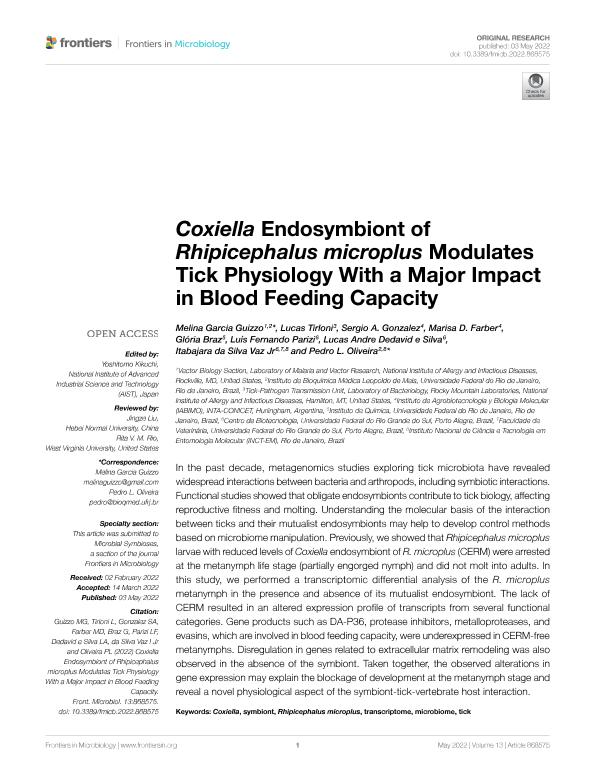Mostrar el registro sencillo del ítem
dc.contributor.author
Guizzo, Melina Garcia
dc.contributor.author
Tirloni, Lucas
dc.contributor.author
González, Sergio Alberto

dc.contributor.author
Farber, Marisa Diana

dc.contributor.author
Braz, Glória
dc.contributor.author
Parizi, Luís Fernando
dc.contributor.author
Dedavid e Silva, Lucas Andre
dc.contributor.author
da Silva Vaz, Itabajara
dc.contributor.author
Oliveira, Pedro L.
dc.date.available
2023-09-28T14:56:08Z
dc.date.issued
2022-05
dc.identifier.citation
Guizzo, Melina Garcia; Tirloni, Lucas; González, Sergio Alberto; Farber, Marisa Diana; Braz, Glória; et al.; Coxiella Endosymbiont of Rhipicephalus microplus Modulates Tick Physiology With a Major Impact in Blood Feeding Capacity; Frontiers Media; Frontiers in Microbiology; 13; 5-2022; 1-13
dc.identifier.uri
http://hdl.handle.net/11336/213461
dc.description.abstract
In the past decade, metagenomics studies exploring tick microbiota have revealed widespread interactions between bacteria and arthropods, including symbiotic interactions. Functional studies showed that obligate endosymbionts contribute to tick biology, affecting reproductive fitness and molting. Understanding the molecular basis of the interaction between ticks and their mutualist endosymbionts may help to develop control methods based on microbiome manipulation. Previously, we showed that Rhipicephalus microplus larvae with reduced levels of Coxiella endosymbiont of R. microplus (CERM) were arrested at the metanymph life stage (partially engorged nymph) and did not molt into adults. In this study, we performed a transcriptomic differential analysis of the R. microplus metanymph in the presence and absence of its mutualist endosymbiont. The lack of CERM resulted in an altered expression profile of transcripts from several functional categories. Gene products such as DA-P36, protease inhibitors, metalloproteases, and evasins, which are involved in blood feeding capacity, were underexpressed in CERM-free metanymphs. Disregulation in genes related to extracellular matrix remodeling was also observed in the absence of the symbiont. Taken together, the observed alterations in gene expression may explain the blockage of development at the metanymph stage and reveal a novel physiological aspect of the symbiont-tick-vertebrate host interaction.
dc.format
application/pdf
dc.language.iso
eng
dc.publisher
Frontiers Media

dc.rights
info:eu-repo/semantics/openAccess
dc.rights.uri
https://creativecommons.org/licenses/by/2.5/ar/
dc.subject
COXIELLA
dc.subject
MICROBIOME
dc.subject
RHIPICEPHALUS MICROPLUS
dc.subject
SYMBIONT
dc.subject
TICK
dc.subject
TRANSCRIPTOME
dc.subject.classification
Biología Celular, Microbiología

dc.subject.classification
Ciencias Biológicas

dc.subject.classification
CIENCIAS NATURALES Y EXACTAS

dc.title
Coxiella Endosymbiont of Rhipicephalus microplus Modulates Tick Physiology With a Major Impact in Blood Feeding Capacity
dc.type
info:eu-repo/semantics/article
dc.type
info:ar-repo/semantics/artículo
dc.type
info:eu-repo/semantics/publishedVersion
dc.date.updated
2023-07-08T00:34:15Z
dc.identifier.eissn
1664-302X
dc.journal.volume
13
dc.journal.pagination
1-13
dc.journal.pais
Suiza

dc.journal.ciudad
Lausana
dc.description.fil
Fil: Guizzo, Melina Garcia. National Institute Of Allergy And Infectious Diseases; Estados Unidos. Universidade Federal do Rio de Janeiro; Brasil
dc.description.fil
Fil: Tirloni, Lucas. National Institute Of Allergy And Infectious Diseases; Estados Unidos
dc.description.fil
Fil: González, Sergio Alberto. Instituto Nacional de Tecnología Agropecuaria. Centro de Investigación en Ciencias Veterinarias y Agronómicas. Instituto de Agrobiotecnología y Biología Molecular. Consejo Nacional de Investigaciones Científicas y Técnicas. Oficina de Coordinación Administrativa Parque Centenario. Instituto de Agrobiotecnología y Biología Molecular; Argentina
dc.description.fil
Fil: Farber, Marisa Diana. Instituto Nacional de Tecnología Agropecuaria. Centro de Investigación en Ciencias Veterinarias y Agronómicas. Instituto de Agrobiotecnología y Biología Molecular. Consejo Nacional de Investigaciones Científicas y Técnicas. Oficina de Coordinación Administrativa Parque Centenario. Instituto de Agrobiotecnología y Biología Molecular; Argentina
dc.description.fil
Fil: Braz, Glória. Universidade Federal do Rio de Janeiro; Brasil
dc.description.fil
Fil: Parizi, Luís Fernando. Universidade Federal do Rio Grande do Sul; Brasil
dc.description.fil
Fil: Dedavid e Silva, Lucas Andre. Universidade Federal do Rio Grande do Sul; Brasil
dc.description.fil
Fil: da Silva Vaz, Itabajara. Instituto Nacional de Ciência E Tecnologia Em Entomologia Molecular; Brasil. Universidade Federal do Rio Grande do Sul; Brasil
dc.description.fil
Fil: Oliveira, Pedro L.. Universidade Federal do Rio de Janeiro; Brasil. Instituto Nacional de Ciência E Tecnologia Em Entomologia Molecular; Brasil
dc.journal.title
Frontiers in Microbiology
dc.relation.alternativeid
info:eu-repo/semantics/altIdentifier/url/https://www.frontiersin.org/articles/10.3389/fmicb.2022.868575/full
dc.relation.alternativeid
info:eu-repo/semantics/altIdentifier/doi/http://dx.doi.org/10.3389/fmicb.2022.868575
Archivos asociados
